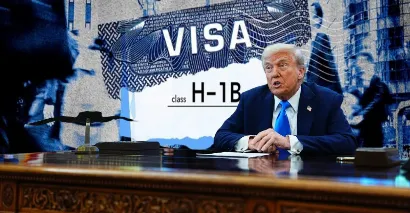Key Highlights
The inaugural $100,000 H-1B visa fee proposed by President Trump marks the first major change in decades in the policy of skilled immigration. The controversial action is a direct response to the growing worries about American tech workers' displacement in the face of widespread industry layoffs. Such a shift in policy will mark a radical shift in the old methods of immigration, and might reform the whole shape of skilled foreign worker recruitment in the United States.
Trump's Historic H-1B Visa Fee Targets Tech Job Protection
This move by the Trump administration to charge H-1B visa applications a huge processing fee of $100,000 marks the conclusion of the decades-long effort by the organizations that feared the displacement of American workers. Kevin Lynn, director of the Institute of Sound Public Policy, had long been advocating the idea of alterations to the foreign worker programmes and suddenly realized he was hearing his message echoed in political quarters.
This policy came after growing impatience with the fact that the tech industry was firing people and still hiring foreign workers. In 2022, tech giants have laid off tens of thousands of employees, yet have kept large H-1B visa programs, which critics call the employment paradox.
Also Read: US Issues Over 1 Million Non-Immigrant Visas to Indians
Tech Industry Layoffs Drive Policy Change
Recent statistics show the sheer lack of connection between corporate layoff notices and foreign worker hiring. Amazon fired tens of thousands of workers and got permission to hire 10,044 H-1B workers in fiscal year 2025, the largest number among leading technology companies. Microsoft laid off 16,000 people and earned record profits at the same time, as it employed thousands of foreigners using the visa program.
The rate of unemployment within computer-related careers has risen by a great margin, especially among fresh graduates who are taking up jobs in the market. Other tech workers, such as software developers, note that they spend long durations finding new jobs, some even getting laid off a couple of times before the company hires a foreign worker to occupy the role.
|
Company |
Layoffs Announced |
H-1B Approvals (FY 2025) |
Ratio |
|
Amazon |
30,000+ |
10,044 |
3:1 |
|
Meta |
25,000+ |
5,123 |
5:1 |
|
TCS |
12,000+ |
5,505 |
2:1 |
|
|
20,000+ |
4,181 |
5:1 |
|
Microsoft |
16,000 |
2,735 |
6:1 |
H-1B Program Structure and Current Usage
The H-1B program offers 85,000 visas per year to skilled foreign workers, 65,000 of which are assigned to general applications, and 20,000 to advanced degree holders. Almost two out of every three approved applications are aimed at positions related to computers, though this was not the original purpose of the program (it was intended to fill specialized skills gaps).
The average H-1B wages are about $100,000, which is close to the normal payment of computer and information technology jobs in the country. This wage match-up contradicts arguments that such jobs need uncommon, hard-to-find, and highly specialized skills that attract high pay.
The existing visas have three-year initial periods and potentially three-year renewals, which provide six-year maximum periods to most beneficiaries. The new fee will only affect applications made after September 21, 2025, and current visa holders should not be impacted by the policy change.
Also Read: Immigration Groups Prepare for Potential Second Trump Administration
Legal Challenges and Industry Response
Coalition groups representing unions, employers, and religious organizations filed the first lawsuit challenging Trump's authority to unilaterally impose the fee increase. Plaintiffs argue the president lacks constitutional power to establish such charges without congressional approval, claiming the policy could foster corruption while stifling innovation.
Business groups issued rare public criticism of the administration's decision, warning that the substantial fee increase risks damaging crucial talent pipelines and harming overall economic competitiveness. Major corporations expressed concerns about their ability to attract international talent in competitive global markets.
The Department of Homeland Security announced plans to prioritize high-skilled, well-compensated applicants in future visa lotteries, moving away from the traditional random selection process. This merit-based approach could favor Indian STEM graduates, who represent the largest pool of H-1B applicants globally.
Impact on Indian Tech Professionals
The highest impacted population under the new fee structure is the Indian nationals, who represent 71% of all H-1B visa approvals. Industry observers believe that the reorientation of policy to a meritocratic approach to selection would, in fact, favor highly skilled Indian professionals with advanced STEM degrees and niche expertise.
The shift poses a threat to the classical model of outsourcing used by such companies as Tata Consultancy Services and Infosys, which submit applications for thousands of H-1B visas every year. These companies encounter more expenses that may essentially change their business plans and pricing patterns.
Other destinations such as Canada, Australia, and Germany are also positioning themselves to take over skilled professionals likely to lose their jobs due to U.S. policy changes. The increase in the H-1B fee was in the interest of Canadian Prime Minister Mark Carney, who publicly expressed his desire to accept talent suffering because of the change.
|
Country |
Visa Program |
Processing Time |
Key Benefits |
|
Canada |
6 months |
Path to citizenship |
|
|
Australia |
8-12 months |
Points-based system |
|
|
Germany |
3-4 months |
Work authorization |
Economic Implications and Future Outlook
Economists generally agree that the net effect of the H-1B program on the U.S. economy has been positive, and research has demonstrated that those companies receiving visa approvals have a higher propensity to generate jobs among native-born workers. But certain classes of workers who have similar skills to those of visa beneficiaries end up competing with more and being suppressed in their wages.
The policy reflects greater anxieties regarding the effects of globalization on American workers, and critics see H-1B visas as part of bigger outsourcing trends. Proponents believe that the rise in fees will prompt businesses to invest in in-country talent development and training.
Difficulties in implementation include administrative bottlenecks, decreased volumes of applications, and even changes to alternative visa categories or offshoring. Other displaced tech workers are not convinced that H-1B restrictions will make much difference in domestic employment opportunities.
Also Read: US Visa Rejection Reasons That You Should Know About
Conclusion
Trump's $100,000 H-1B visa fee emerges from legitimate concerns about American tech worker displacement amid widespread industry layoffs and continued foreign worker recruitment. The policy reflects growing political pressure to prioritize domestic employment over cost-saving foreign labor strategies. While legal challenges and industry opposition continue mounting, the fee structure represents the most significant skilled immigration policy shift in recent decades.
For official information about H-1B visa fees and application procedures, visit the U.S. Citizenship and Immigration Services (USCIS) website, which provides comprehensive details about current fee structures, filing requirements, and processing timelines. To know more about Trump's policy changes, visit TerraTern now!








